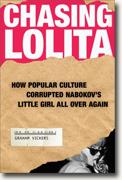Chasing Lolita
Graham Vickers
book reviews:
· general fiction
· chick lit/romance
· sci-fi/fantasy
· graphic novels
· nonfiction
· audio books
· author interviews
· children's books @
curledupkids.com
· DVD reviews @
curledupdvd.com
newsletter
win books
buy online
links
home
for authors
& publishers
for reviewers

 |
Chasing Lolita: How Popular Culture Corrupted Nabokov's Little Girl All Over Again Graham Vickers Chicago Review Press Hardcover 256 pages August 2008 |
|
ďYou must be confusing me with some other fast little article,Ē says Lolita to her stepfather, Humbert, in Vladimir Nabokovís controversial novel Lolita. Ever since its publication in 1958, readers, critics, media personalities, journalists, and the general public have been busy confusing Lolita, twisting her story to conform to their own preconceived ideas. Graham Vickers gives us the history of Lolita and examines what 50 years of pop culture have done to co-opt the image of Lolita into the seductive temptress she is known as today.
Vickers spends times investigating the real-life precursors to the Lolita story, focusing on Charles Dodgsonís fascination with Alice Liddell and Charlie Chaplinís fondness for young girls, including his short marriage to the teenaged Lillita. He then examines the difficulties Nabokov experienced in getting Lolita published, fighting worldwide censors and allegations of obscenity. Vickers then examines the many attempts at bringing Lolita off the printed page and into visual media. The first attempt was Stanley Kubrickís 1962 film. Despite a screenplay written by Nabokov himself, Kubrick elected to change so much of the story that Lolita and Humbert become different characters, and Nabokov was vocally disappointed. In 1971, famed lyricist Alan Jay Lerner opened a musical called Lolita, My Love, which received such bad reviews that it closed after only nine performances. In 2005, playwright Edward Albeeís Lolita debuted in New York City to equally dismal reviews. Not until director Adrian Lyneís movie in 1997 did Lolita receive critical acclaim. Because of itís proximity to the Child Pornography Prevention Act of 1996, Lyneís movie almost never got distributed and eventually opened in Europe. While Lyne takes liberties with the story, he retains many of the novelís unique details, and Nabokovís son, Dmitri has openly endorsed it. Vickerís book is most interesting when he breaks away from the history and examines the ways in which pop culture has changed the meaning of the word Lolita. Beginning with Kubrickís promotional posters for his movie, the media has been purposefully portraying Lolita in overtly sexual poses. The famous lollipop and heart-shaped sunglasses are fully inventions of a media intent on promoting Lolita as a purely sexual entity. Artist Graham Ovendenís series of "Lolita" paintings seem to eroticize Lolita in ways that Nabokov never intended. In the famous case of Amy Fisher, the Long Island Lolita, the blame for a horrifying sequence of events is placed on the shoulders of a seventeen-year-old girl while the man involved was practically absolved of guilt. Overnight, the term Lolita came to be synonymous with slut, a young woman who sets out to seduce and destroy an older man. One of the most tragic uses of the Lolita image is in the series of pornographic films produced in the 1970s featuring young girls between the ages of seven and eleven. Photos from these movies were then sold to the Dutch pornographic magazine Lolita. Vickers writes an interesting, entertaining look at the history and myth of the famous, and infamous, Lolita. An obvious fan of the novel, Vickers assembles an interesting and thought-provoking collection of anecdotes about a novel that has been fascinating readers for 50 years. Readers who love the novel, or who are interested in the portrayal of women in society, will find much in this book to enjoy. Originally published on Curled Up With A Good Book at www.curledup.com. © Elizabeth Schulenberg, 2008 |
|
|
|
 Click here to learn more about this month's sponsor! |
|
| fiction · sf/f · comic books · nonfiction · audio newsletter · free book contest · buy books online review index · links · · authors & publishers reviewers |
|
| site by ELBO Computing Resources, Inc. | |
 Vickers gives readers a brief synopsis of Nabokovís novel and stresses that, when Dolores Haze was first introduced to readers, she was a 12-year-old child, not the brazen seductress she has morphed into. Nabokov gives no indication that she was anything other than a normal, somewhat gawky schoolgirl. The first vision of Lolita as overtly sexual comes in a publicity poster for Stanley Kubrickís 1962 film version of the story, and from then on Lolitaís fate has been sealed.
Vickers gives readers a brief synopsis of Nabokovís novel and stresses that, when Dolores Haze was first introduced to readers, she was a 12-year-old child, not the brazen seductress she has morphed into. Nabokov gives no indication that she was anything other than a normal, somewhat gawky schoolgirl. The first vision of Lolita as overtly sexual comes in a publicity poster for Stanley Kubrickís 1962 film version of the story, and from then on Lolitaís fate has been sealed.